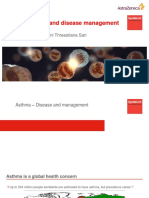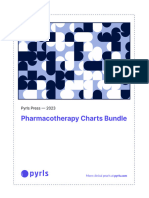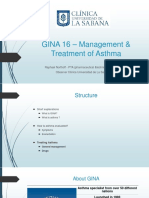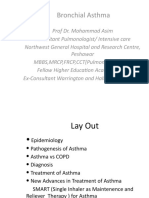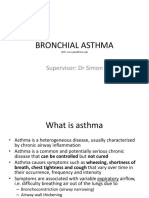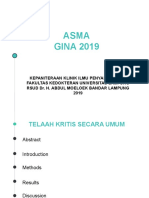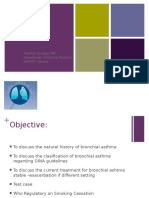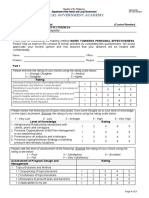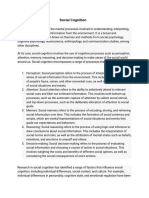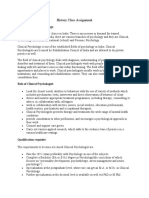Guideline approaches to stepping up asthma controller therapy in adolescents and adults
Official reprint from UpToDate® www.uptodate.com
©2024 UpToDate®
Guideline approaches to stepping up asthma controller therapy in
adolescents and adults
National Asthma Education and [3]
[1,2] Global Initiative for Asthma (GINA)
Prevention Program (NAEPP)
Qualifying criteria Therapy * Qualifying criteria Therapy
Step 1 Step 1
All of the following at SABA, as needed All of the following at Low-dose ICS-
initiation of therapy or initiation of therapy or formoterol as
using SABA alone: using SABA alone: needed
Daytime Infrequent (preferred) Δ
symptoms ≤2 asthma or
days/week symptoms (eg, Low-dose ICS-SABA
Nocturnal <2 times/week) or ICS plus SABA,
awakenings No risk factors concomitantly
≤2/month for administered, as
Normal FEV1 exacerbations ¶ needed Δ
Exacerbations
≤1/year
Step 2 Step 2
Poor asthma symptom Low-dose ICS daily Poor asthma symptom Low-dose ICS-
control, * and SABA as control, * formoterol as
exacerbations needed exacerbations needed
requiring systemic or requiring systemic (preferred) Δ
glucocorticoids, or Low-dose ICS-SABA glucocorticoids, or or
high risk of or ICS plus SABA, high risk of Low-dose ICS daily
exacerbation ¶ on Step concomitantly exacerbation ¶ on Step and SABA as
1 therapy despite: administered, as 1 therapy despite: needed
Addressing needed Δ Addressing
Other options
modifiable modifiable
Alternative option(s) Low-dose ICS-
environmental environmental
Daily LTRA and SABA or ICS plus
factors and factors and
SABA as needed SABA,
comorbidities comorbidities
concomitantly
Good adherence Good adherence
administered, as
and inhaler and inhaler
- Page 1 of 5 - Δ
�Guideline approaches to stepping up asthma controller therapy in adolescents and adults
technique technique needed Δ
or (less
preferred)
LTRA daily and
SABA as needed
Step 3 Step 3
Poor asthma symptom Low-dose ICS- Poor asthma control, * Low-dose ICS-
control, * formoterol as exacerbations formoterol as
exacerbations maintenance and requiring systemic maintenance and
requiring systemic reliever therapy glucocorticoids, or reliever therapy
glucocorticoids, or (preferred) ◊ high risk of (preferred) ◊
high risk of exacerbation ¶ on Step or
Alternative option(s)
exacerbation ¶ on Step 2 therapy despite: Low-dose ICS-LABA
Medium-dose ICS
2 therapy despite: Addressing combination daily
daily and SABA
Addressing modifiable and SABA as
as needed
modifiable environmental needed
or
environmental factors and
Low-dose ICS- Other options
factors and comorbidities
LABA Medium-dose ICS
comorbidities Good adherence
combination daily and SABA
Good adherence and inhaler
daily or ICS-SABA as
and inhaler technique
or low-dose ICS needed
technique
plus LAMA daily or
or low-dose ICS Low-dose ICS
plus anti- plus LTRA daily
leukotriene daily and SABA or ICS-
and SABA as SABA Δ as needed
needed
Step 4 Step 4
Poor asthma symptom Medium-dose ICS- Poor asthma symptom Medium-dose ICS-
* *
control, formoterol as control, formoterol as
exacerbations maintenance and exacerbations maintenance and
requiring systemic reliever therapy requiring systemic reliever therapy
glucocorticoids, or (preferred) ◊ glucocorticoids, or (preferred) ◊
high risk of high risk of or
Alternative option(s)
exacerbation ¶ on Step exacerbation ¶ on Step Medium-dose ICS-
Medium-dose
3 therapy despite: 3 therapy despite: LABA daily and
ICS-LABA
Addressing Addressing SABA or ICS-SABA Δ
combination
modifiable modifiable as needed
daily
environmental environmental
or medium-dose Other options
- Page 2 of 5 -
�Guideline approaches to stepping up asthma controller therapy in adolescents and adults
factors and ICS plus LAMA factors and Possible add-on
comorbidities daily comorbidities LAMA or switch
Good adherence or medium-dose Good adherence to ICS-LAMA-
and inhaler ICS plus anti- and inhaler LABA
technique leukotriene daily technique Possible add-on
and SABA as LTRA
needed §
Step 5 Step 5
Poor asthma control, * Medium- to high- Poor asthma symptom Medium-dose ICS-
*
exacerbations dose ICS-LABA plus control, formoterol as
requiring systemic LAMA daily (or ICS- exacerbations maintenance and
glucocorticoids, or LAMA-LABA daily) requiring systemic reliever therapy
high risk of and SABA as glucocorticoids, or plus LAMA daily
¶
exacerbation on Step needed (preferred) high risk of (preferred) ◊
4 therapy despite: or exacerbation ¶ on Step or
Addressing Medium- to high- 4 therapy despite: Medium-dose ICS-
modifiable dose ICS-LABA daily Addressing LABA daily plus
environmental plus LTRA daily and modifiable LAMA daily (or ICS-
factors and SABA as needed § environmental LAMA-LABA daily)
comorbidities factors and and SABA or ICS-
and
Good adherence comorbidities SABA Δ as needed
and inhaler Assess asthma Good adherence
and
technique phenotype and and inhaler
evaluate for technique Assess asthma
possible addition of phenotype and
asthma biologics ¥ evaluate for
possible addition of
asthma biologics ¥
Other options
Possible add-on
LTRA or
azithromycin
Possible high-
dose ICS-LABA
trial (3 to 6
months)
This table illustrates major guideline recommendations for ongoing asthma therapy. At follow-up
visits, check adherence, inhaler technique, environmental factors, and comorbid conditions.
Subcutaneous immunotherapy is suggested as an adjunct to standard pharmacotherapy in
individuals who have demonstrated allergy to the included allergens and whose asthma is well
- Page 3 of 5 -
�Guideline approaches to stepping up asthma controller therapy in adolescents and adults
controlled whenever immunotherapy is administered. Consultation with an asthma specialist is
recommended if step 4 or higher is required. Therapeutic strategies for newly diagnosed patients
or for patients using SABA therapy alone are covered separately. For additional information, please
refer to UpToDate content on initial and ongoing treatment of asthma.
DPI: dry powder inhaler; FEV1: forced expiratory volume in one second; ICS: inhaled corticosteroid
(glucocorticoid); IgE: immunoglobulin E; IL: interleukin; LABA: long-acting beta-agonist; LAMA:
long-acting muscarinic antagonist; LTRA: leukotriene receptor antagonist; MDI: metered-dose
inhaler; SABA: short-acting beta-agonist.
* Good asthma symptom control is generally defined as bothersome asthma symptoms or need
for SABA inhaler less than twice a week, no nocturnal awakenings, and no activity limitations due
to asthma. For patients on ICS-formoterol, ICS-SABA, or ICS plus SABA reliever therapy (aka, anti-
inflammatory reliever therapy), reliever use more frequently (but less than daily) is reasonable as
long as other symptoms are well controlled.
¶ Risk factors for exacerbations include: poor asthma symptom control, a history of asthma
exacerbation on the current regimen, smoking, allergen exposure if sensitized, previous intubation
or intensive care unit stay for asthma, low FEV1 (especially <60% predicted), obesity, food allergy,
chronic rhinosinusitis, and poor adherence/inhaler technique. Please refer to UpToDate asthma
treatment content and separate graphic on risk factors for asthma exacerbation.
Δ When prescribed for use as-needed for acute asthma symptoms, ICS-formoterol, ICS-SABA, and
concomitant ICS and SABA use are referred to as anti-inflammatory reliever therapy. Compared
with SABA relievers, use of anti-inflammatory reliever therapy has demonstrated decreased
exacerbation risk in patients with all degrees of asthma severity.
◊ ICS-formoterol prescribed for use as both maintenance therapy and for acute relief of symptoms
is referred to as maintenance and reliever therapy (MART). MART has been shown to be more
effective in terms of exacerbation reduction and symptom relief compared with ICS-formoterol and
SABA alone as reliever therapy.
§ Theophylline and cromolyn are not included in the table even though they were included in
NAEPP-EPR 3 (2007), and theophylline is included in NAEPP (2020). These agents are rarely used
due to availability of more effective options.
¥ Asthma biologics include anti-immunoglobulin E, anti-IL-5, anti-IL-5R, anti-IL-4R (anti-IL-4/IL-13),
and anti-thymic stromal lymphopoietin (anti TSLP). Refer to UpToDate graphic on our approach to
selection of biologic agents for add-on therapy for severe asthma in adolescents and adults.
References:
1. National Heart, Lung, and Blood Institute. National Asthma Education and Prevention Program: Expert panel
report III: Guidelines for the diagnosis and management of asthma. Revised August 2007 (NIH publication
no. 07-4051). Available at: https://www.nhlbi.nih.gov/health-topics/guidelines-for-diagnosis-management-of-
asthma (Accessed November 3, 2023).
2. National Heart, Lung, and Blood Institute. 2020 focused updates to the asthma management guidelines: A
report from the National Asthma Education and Prevention Program Coordinating Committee Expert Panel
- Page 4 of 5 -
�Guideline approaches to stepping up asthma controller therapy in adolescents and adults
Working Group. December 2020 (NIH publication no. 20-HL-8140). Available at:
https://www.nhlbi.nih.gov/health-topics/asthma-management-guidelines-2020-updates (Accessed November
3, 2023).
3. Global Initiative for Asthma (GINA). Global strategy for asthma management and prevention, 2023. Updated
July 2023. Available at: https://ginasthma.org/2023-gina-main-report/ (Accessed November 8, 2023).
Graphic 143333 Version 1.0
© 2024 UpToDate, Inc. All rights reserved.
- Page 5 of 5 -









